Cast-iron architecture
Cast-iron architecture is the use of cast iron in buildings and objects, ranging from bridges and markets to warehouses, balconies and fences. Refinements developed during the Industrial Revolution in the late 18th century made cast iron relatively cheap and suitable for a range of uses, and by the mid 19th century it was common as a structural material (and sometimes for entire buildings), and particularly for elaborately patterned architectural elements such as fences and balconies, until it fell out of fashion after 1900 as a decorative material, and was replaced by modern steel and concrete for structural purposes.

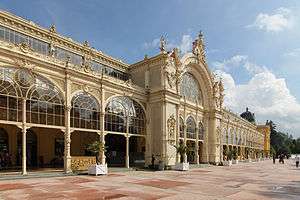
Structural use
Cast iron is not a good structural material for handling tension or bending moments because of its brittleness and relatively low tensile strength compared to steel and wrought iron. Cast iron has good compressive strength and was successfully used for structural components that were largely in compression in well designed bridges and buildings. In a few instances bridges and buildings built with cast iron failed when the cast iron was used poorly.
Cast iron was used as early as the 9th century in pagoda construction in Tang Dynasty China.[1] Texts written by the Japanese Buddhist monk Ennin describe in detail the cast-iron pagodas and statues widespread in China at the time. Persecution of Buddhism in China led to the destruction of many of these structures.[1] The later Song Dynasty also built cast iron pagodas, exploiting its ability to be both structural and to be cast in any shape, such as in imitation of the timber and tiles of a standard pagoda. The 22m Iron Pagoda at the Yuquan Temple (Jade Springs Temple), Dangyang, Hubei, was built during the Song Dynasty in 1061, and is the most outstanding example to survive. Cast iron pagodas were then superseded by even more elaborate bronze ones, but cast iron continued to be used for decorative items such as bowls and statues.
In Europe, it was in late 18th-century Britain that new production methods first allowed cast iron to be produced cheaply enough and in large enough quantities to regularly be used in large building projects. New production methods included using steam engine powered blast air, which allowed higher blast furnace temperatures, which in turn allowed the use of more limestone to be added with the iron ore charge. The higher furnace temperatures made the slag produced with the additional lime to flow more freely. The calcium and magnesium in the lime helped tie up sulfur, which allowed the use of coke for fuel. The higher furnace temperatures also increased the furnace capacity.[2]

One of the first important projects was The Iron Bridge in Shropshire, opened in 1781, a precedent-setting structure made almost entirely of cast iron. However, it was grossly over-designed, and the makers (principally Abraham Darby) suffered financially as a result. The quality of the iron used in the bridge is not high, and nearly 80 brittle cracks are visible in the present structure. Nevertheless, its success led to the use of cast iron for further bridges and structures by the Coalbrookdale foundries and others.
Engineer Thomas Telford improved both the design and quality of the material in bridges, for example, at Buildwas, upstream of Coalbrookdale, built in 1796, and also for aqueducts, such as the world-famous Pontcysyllte Aqueduct in North Wales, built in 1805, where both the arches and the trough are constructed of cast iron. On the continent, the 1804 Pont des Arts in Paris is an early and elegant use of cast iron for a major city river crossing (the metal work of the current bridge is a near identical copy built in 1984 due to structural decay).
Another notable example is the elegant Ha'penny Bridge in Dublin, cast by the Coalbrookdale foundry, and built in 1816.
.jpg)
Cast-iron columns for buildings had the advantage of being extremely slender, compared with masonry columns capable of supporting similar weight. That saved space in factories, and so after the five-storey 1795 Ditherington Flax Mill with its internal structure of cast-iron proved the concept, it became ubiquitous in the multi-level mills of northern England, and then further afield in all kinds of industrial and multi-storey structures, up until about 1900. It was also useful in other kinds of buildings, for instance enabling architects of theaters, churches and synagogues to improve sight lines when supporting balconies, by eliminating or at least making the columns that supported the roof or balconies thinner. Cast iron was used in place of timber in some buildings in the early-mid 19th century where smaller supports or larger spans were required (and where wrought iron was too expensive), notably in the Royal Pavilion in Brighton, designed by John Nash and built between 1816-1823, where cast iron columns were used within the walls, as well as cast iron beams, to enable the construction of the decorative domes; the columns in the kitchens were disguised as palm trees.[3] Cast iron was also used as the principle support structure for seaside piers, with multiple slender columns able to support long decks of wrought iron and wood, and later large halls and pavilions; engineer Eugenius Birch built the first, Margate Pier in 1855, followed by at least 14 piers in the 1860s-80s.
Cast iron was not useful for items in tension like beams, where the more expensive wrought iron was preferred. Improvements in production saw the costs decrease at the same time as cast iron gained popularity. The puddling process, patented in 1784, was a relatively low cost method for producing a structural grade wrought iron. Puddled wrought iron was a much better structural material, and was preferred for bridges, rails, ships and building beams, and was often used in combination with cast iron, which was better in compression. Steel was an even better structural material than wrought iron, and new steel making processes developed in the late 19th century[4] greatly lowered the cost of production to far below the cost of wrought iron.[4] The widespread use of cast-and-wrought iron frames in multi-level buildings was translated into steel-frame buildings, and was an essential step in the development of the modern skyscraper.
Architectural use
In Europe, cast iron had been occasionally used with architectural embellishment in the middle ages, such as fire backs with cast figures and scenes.[5] The improvements in techniques in the late 18th century led to the possibilities of finer castings, allowing decorative objects such as statuary and jewelry to be mass produced. Following the development of the material as for structural purposes, it was soon adapted for uses that were both decorative and structural in all manner of buildings, structures and objects.
Early balustrades, railings and memorials
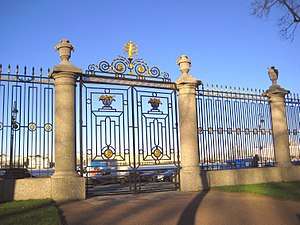
As soon as improvements in techniques led to finer castings, designers exploited the decorative possibilities. As early as 1775, noted architect Robert Adam joined with the Scottish Carron Company iron works to produce balcony railings in imitation of wrought iron, such as the railing for the Adelphi in London (a pattern that was still produced into the 1830s).[6] Another very early large scale example is the delicate fence of the Summer Garden in St Petersburg, designed by Georg Von Veldten, built between 1771-1784, which also imitated wrought iron, and is considered the pinnacle of cast iron design in the city. Other well known architects were early adopters of the material; John Nash employed cast iron as part of the structure of his landmark 1820s Royal Pavilion in Brighton, and German architect Karl Friedrich Schinkel was an enthusiastic early adopter, using cast iron for memorials such as the 20m tall Gothic Revival Kreuzberg War Memorial in 1821, and the delightful nautical seahorses and mermaids in the balustrade of the 1820s Castle Bridge in Berlin.
.jpg)
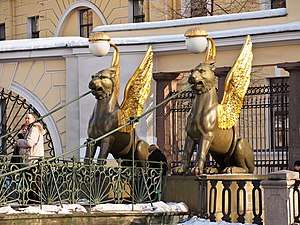
In Saint Petersburg, cast iron was used on the many bridges, sometimes as the supporting structure, but especially for the decorative railings and sculptural embellishments, including the chain-suspension 1826 Bank Bridge, with its distinctive cast iron griffin sculptures and elaborate balustrades, the 1840 Pevchesky Bridge, the 1842 Anichkov Bridge (a copy of the Berlin Castle Bridge), and more seahorses on the 1843-1850 Annunciation Bridge.
Prefabricated buildings
Since it could be used for all the structural members that would be cast in a foundry and then transported to site for erection, it was soon realised it could just as easily be transported anywhere in the world. The Commissioner's House of the Royal Naval Dockyard, Bermuda designed by Edward Holl and built in the 1820s, is considered to be the first residence that used cast iron structure, for the verandahs, and floor and roof framing, and proved the concept of prefabrication and transportation long distances.[7][8] Designers and foundries in the UK and France went on to produced all kinds of prefabricated cast iron structures and items for shipping to their colonies, from decorative elements to structural components to entire buildings. During the Victorian gold rush in Australia in the 1850s hundreds of various types of prefabricated structures were shipped out from England, in timber, cast or wrought iron, or a combination, often with corrugated iron for the walls and roof. They included houses, stores, three complete churches, and a theatre; the most elaborate surviving structure is the completely cast iron Corio Villa, in Geelong.[9] Markets were a type of structure that lent themselves to prefabrication and shipping, such as the structure of the Mercado Centrale in Santiago, Chile, which was shipped out from Glasgow firm Laidlaw & Sons in 1869. The Marché en Fer (Iron Market) in Port au Prince, Haiti, fabricated in Paris, was reputedly intended as a railway station for Cairo in 1891 but was purchased by the Haitian government instead. Watson's Hotel in Mumbai was prefabricated in England and built in 1867-69, using brick infill panels in a heavy and decorative cast-iron frame and is the oldest completely cast iron framed building in the world. Possibly the largest prefabricated cast iron structure is the Bulgarian St. Stephen Church in Istanbul, shipped out from Vienna in the late 1890s.
Verandahs and porches
The use of decorative cast iron as railings, fences and balconettes then gradually gained popularity in Regency Britain and post-Napoleonic France as a cheaper alternative to the wrought-iron railings that only the wealthy could afford. The idea was exported to the colonies of both countries with hot climates as porches or verandahs, where it formed both decoration and structure.
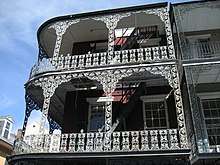
New Orleans' French Quarter has the most famous and elaborate examples and the greatest concentration, with light, lacy often multi-level porches on over 400 buildings, transforming the area from the 1850s-1880s.[10] A few similar porches can be found in Savannah's Historic District, and the Church Hill and Jackson Ward neighborhoods in Richmond, though here it is mostly used for stair, porch and balcony railings. Numerous foundries in all three cities produced unique ornamental and structural designs in cast iron.
In Australia, similar porches of usually only one or two levels, known as vernadhas, decorated with 'cast-iron lace', became a standard feature, shading the fronts of nearly every house, terrace house, pub and shop from the 1850s into the 1900s.[11] Foundries in most cities and (with 42 in Melbourne alone[12]) and many country towns began by reproducing imported designs in the 1850s and then developing their own, sometimes featuring Australian fauna such as cockatoos and koalas,[13] but most featured flowing classically derived vine-like patterns. After a period in the 1950s-60s when cast iron verandahs were routinely demolished,[14] since the late 1970s they made a revival, and numerous foundries still provide historic patterns to order.[15][16] Decorative cast iron used in a similar way can be found in other former British colonies including South Africa, Malaysia and India.
Cast iron facades

In the 1840s the cheapness and malleability of cast iron led James Bogardus of New York City to develop the idea of buildings using cast iron for complete decorative facades, which were far cheaper than traditional carved-stone, but could be painted to give the appearance of stone. His first was put up in 1848, quickly followed by many more, and he promoted the idea in a pamphlet Cast Iron Buildings: Their Construction and Advantages (1858). The idea was taken up by other notable pioneer Daniel D. Badger, whose iron works in the East Village turned out "some of the most dramatic iron buildings this country has ever seen",[17] most notably the E. V. Haughwout Building in 1857. Particularly popular for warehouse / industrial buildings, but also for department stores, the streets of the SoHo and Tribeca areas of New York were soon lined with elaborate Renaissance Revival style facades. Warehouse districts in other US cities in the period soon also saw many examples, but most have been demolished. The West Main District, Louisville Kentucky has the most surviving examples, with about 10 in a three block stretch. The Skidmore/Old Town Historic District in Portland, Oregon also features a number of examples remaining from a once extensive district. In Europe cast-iron architecture was never popular, except in the growing industrial city of Glasgow, Scotland, where a few survive, such as the 1872 Ca d’Oro Building.
Glass roofs, markets and halls
Cast iron also became the standard support structure in the construction of larger greenhouses. English architect and gardener Joseph Paxton experimented with frameworks of timber, cast-iron and glass in the 1820s and 30s, designing ever larger structures, often prefabricated, culminating in the monumental Crystal Palace exhibition hall built in London in 1851. The success of the concept spawned many imitators, as both exhibition halls and greenhouses, which were almost universally constructed of cast iron (sometimes in combination with wrought-iron) in the 19th century.
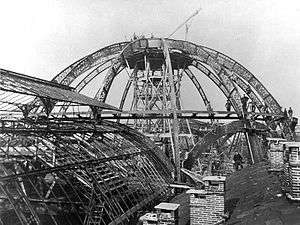
Cast iron was quickly adapted to allow glass roofs on a wide variety of structures, perhaps beginning with the new glass-roofed shopping arcades of the 1820s in Paris and London, then larger spans (sometimes in combination with wrought iron) such as market halls, railway stations, and department stores. By the end of the 19th century nearly every new market hall in Europe (and most in Latin America) had glass and cast-iron roofs, some vast and elaborate, such as the 1850s Les Halles in Paris (demolished).
An interesting application is for a winter garden, with a solid roof but extensive glass walls, such as the Spa Colonnade in the spa town of Mariánské Lázně in Czechia, built in 1889, which features an elaborate roof structure and extensive Neo-Baroque decorations in the facade, all in cast iron.
Roofs, domes and atriums
Cast iron was used for the construction of large domes, often incorporating glass, as early as 1811, with the glass dome of the Bourse de commerce in Paris.The central four storey circular hall and towering glass dome[18] of the long-demolished 1849 London Coal Exchange was an early and spectacular use of the material as both structure and architecture. The 1872 George Peabody Library in Baltimore is a similarly elaborate atrium with glass roof, where all the structural members are also decorative and made of cast iron. The lofty glass roof of Milan's Galleria, built 1865-77, is both a dome and glass roofed shopping arcade, the grandest ever built.[19] Later glass roofs such as that of the Grand Palais in Paris employed wrought iron or steel.
Other domes and roofs were built using extensive cast iron structures, with cast iron beams used to support the pyramidal roofs of the Palace of Westminster (1840s-50s), and an elaborate cast iron frame for the dome of Saint Isaac's Cathedral in St Petersburg (1837-38). The most famous example is the United States Capitol dome, built 1855-66, entirely made of cast iron, painted to look like stone.
Two famous examples of cast iron as both support and decoration of a roof on slender columns are the two great mid 19thC libraries of Paris, the double-arched roof of the Bibliothèque Sainte-Geneviève reading room, built 1843-51, by architect Henri Labrouste, who also designed an even more elegant multiple-domed reading room for the Bibliothèque nationale de France, built 1861-68.
Street furniture and park items
Cast iron, a durable material that take on any shape, was also popular from the mid 19th Century for street furniture. Not only park and building fences, often with elaborate gates, but also street lamps, bollards, tree grates and guards, as well as the UK red post box, and in Paris it was used for the elaborate advertising columns, newspaper kiosks and pissoirs the city is known for (though almost all are now contemporary reproductions in other materials). In the 1870s philanthropist Charles Wallace funded the installation of numerous ornate drinking fountains across Paris, and over 100 Wallace Fountains are still in use. Decorative street lamps in cast iron were used all over the world, from gas lamps in the second half of the 19th Century to electric ones in the first decades of the 20th - a collection of examples used in California in the 1920s and 30s now form a display outside the Los Angeles County Museum of Art, called Urban Light.[20] When underground trains were established in the 1890s-1900s, the stairs located in pavements were often housed in elaborate cast iron structures, notably the long demolished New York City Subway entrances (one survives at City Hall station outside New York City Hall), and the famous Art Nouveau Paris Métro entrances by Hector Guimard.
For the same reasons, cast iron was also popular for structures within parks and gardens, both public and private, as well as on public promenades, used for fencing, seating, lamp posts, large fountains and drinking fountains, statues, decorative bridges, covered walkways, gazebos and bandstands. The 1885 Morisco Kiosk in Mexico City is a particularly elaborate example of the latter (though this may be wrought rather than cast iron). The 1870s Victoria Embankment in London features particularly ornate examples, with entwined dolphins supporting elaborate lampposts, and benches with sphinxes or camels as end panels.
Gallery
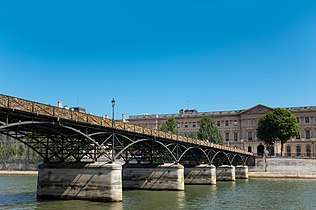 Pont Des Arts, Paris, 1804
Pont Des Arts, Paris, 1804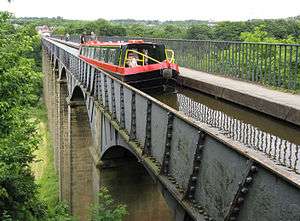 Pontcysyllte aqueduct, North Wales, 1805
Pontcysyllte aqueduct, North Wales, 1805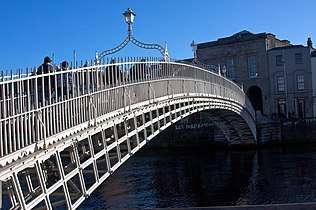 Ha'penny Bridge, Dublin, 1816
Ha'penny Bridge, Dublin, 1816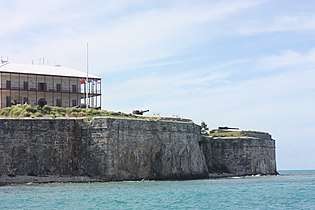 Commissioners House, Bermuda, 1820s
Commissioners House, Bermuda, 1820s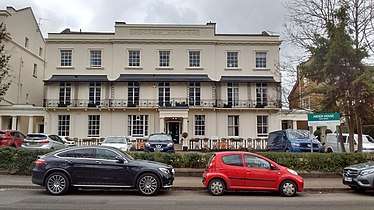 Cast iron balcony and railing, Arden House, Leamington Spa, England, 1832.
Cast iron balcony and railing, Arden House, Leamington Spa, England, 1832._-_Vue_d'ensemble_en_cours_de_construction_-_Paris_01_-_M%C3%A9diath%C3%A8que_de_l'architecture_et_du_patrimoine_-_APMH00012727.jpg) Bourse de Commerce dome, Paris, 1811 (photo 1880s)
Bourse de Commerce dome, Paris, 1811 (photo 1880s) Kreuzberg Memorial, Berlin, 1821.
Kreuzberg Memorial, Berlin, 1821. Kitchen with palm tree cast iron columns, Royal Pavilion, Brighton, c1820
Kitchen with palm tree cast iron columns, Royal Pavilion, Brighton, c1820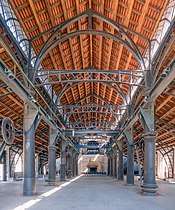 Sayn Foundry hall, Bendorf Germany, 1830.
Sayn Foundry hall, Bendorf Germany, 1830. Cast iron balcony, town hall, 9th arrondissement, Paris, c1830
Cast iron balcony, town hall, 9th arrondissement, Paris, c1830 St Isaac's Cathedral dome structure, c1838
St Isaac's Cathedral dome structure, c1838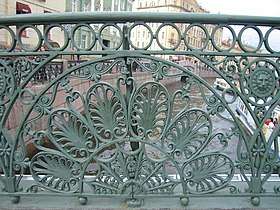 Pevchesky Bridge, St Petersburg, 1840
Pevchesky Bridge, St Petersburg, 1840 Eisernes Haus, 1848, today part of Kunsthaus Graz
Eisernes Haus, 1848, today part of Kunsthaus Graz Bibliotheque Sainte-Genevieve, Paris, 1843-50
Bibliotheque Sainte-Genevieve, Paris, 1843-50- King Frederick Augustus Tower, Löbau, Germany 1852
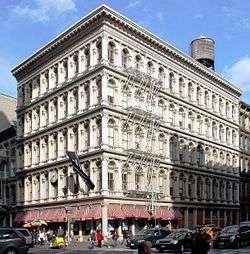 Haughwout Building, Soho, NY, 1856-7
Haughwout Building, Soho, NY, 1856-7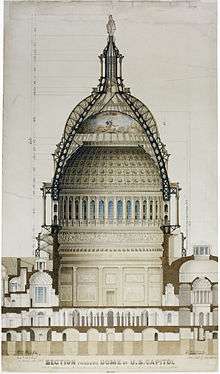 U.S. Capitol section, 1859
U.S. Capitol section, 1859.jpg) Salle Labrouste, Bibliothèque nationale de France, 1861-68
Salle Labrouste, Bibliothèque nationale de France, 1861-68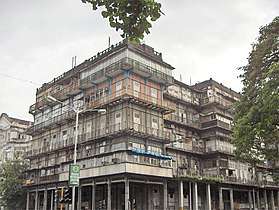 Watson's Hotel, Mumbai, 1869
Watson's Hotel, Mumbai, 1869- Mercado Central, Santiago, Chile, 1869
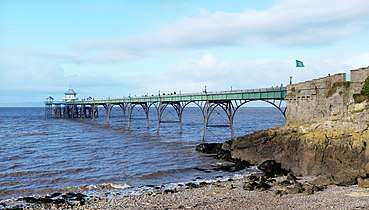 Clevedon Pier, South Wales, 1869, cast iron base structure.
Clevedon Pier, South Wales, 1869, cast iron base structure. Sphinx bench, Victoria Embankment, London, 1877
Sphinx bench, Victoria Embankment, London, 1877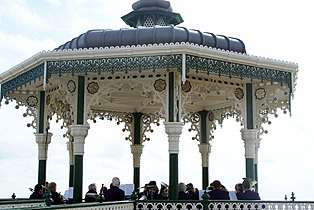 Brighton Beach Bandstand, Brighton UK, 1884
Brighton Beach Bandstand, Brighton UK, 1884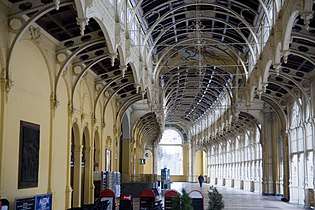 Spa Colonnade, Mariánské Lázně, Czechia, 1889
Spa Colonnade, Mariánské Lázně, Czechia, 1889- Cast Iron building St Louis, Missouri
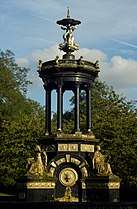 Cast iron fountain, Alexandra Park, Glasgow, 1901
Cast iron fountain, Alexandra Park, Glasgow, 1901- Old cast-iron bench, Bad Kissingen, Germany
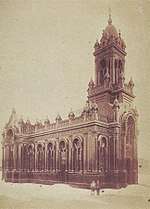 St Stephen's Bulgarian Church, Istanbul, 1898
St Stephen's Bulgarian Church, Istanbul, 1898.jpg) Mikhailovsky Garden fence, St Petersburg, 1907
Mikhailovsky Garden fence, St Petersburg, 1907.jpg) Lamps on Elgin Bridge (Singapore), 1929
Lamps on Elgin Bridge (Singapore), 1929 Typical Sydney iron lace terrace houses in Woollahra, New South Wales, late 19th century
Typical Sydney iron lace terrace houses in Woollahra, New South Wales, late 19th century
References
Notes
- The Coming of the Ages of Steel. Brill. 1961. p. 55. GGKEY:DN6SZTCNQ3G.
- Tylecote, R. F. (1992). A History of Metallurgy (Second ed.). London: Maney Publishing, for the Institute of Materials. pp. 122–125. ISBN 978-0901462886.CS1 maint: ref=harv (link)
- "Engineering Timelines - Royal Pavilion, Brighton". www.engineering-timelines.com. Retrieved 2019-12-28.
- Landes (1969), pp. 91–93.
- "Fire back | V&A Search the Collections". V and A Collections. 2020-01-28. Retrieved 2020-01-28.
- "Balcony panel | Adam, Robert | V&A Search the Collections". V and A Collections. 2020-01-28. Retrieved 2020-01-28.
- "Bermuda Maritime Museum". Archived from the original on March 29, 2010. Retrieved October 12, 2009.
- Restoration of the Commissioner's House Archived 2008-12-03 at the Wayback Machine
- "Corio Villa". Victorian Heritage Database.
- Advocate, RICHARD CAMPANELLA | Special to The. "City signature: Now a mainstay, iron-lace galleries were a long time coming to the streets of New Orleans". NOLA.com. Retrieved 2019-10-25.
- Lewis, Miles. "Ornamental Cast Iron" (PDF). Miles Lewis Australian Building.
- Brown, Jenny (2011-07-30). "The city's signature is cast in iron". Domain. Retrieved 2019-10-17.
- "Origins of Lacework & Balustrade Designs | Chatterton Lacework". www.chatterton.com.au. Retrieved 2019-10-17.
- "Architectural elements, balustrade panels (7), cast iron lace, removed in 1970s from verandah of a house in Glebe, Sydney, New South Wales, Australia, made in Australia, 1880-1890". collection.maas.museum. Retrieved 2019-10-17.
- "Lacework Designs" (PDF). Chatterton.
- "- Cast Iron Lacework [L42C]". www.perrybirdpickets.com.au. Retrieved 2019-10-17.
- Gayle, Margot. Cast Iron Architecture in America. New York: Dover Books, 1974
- "J. B. Bunning's London Coal Exchange (1849)". www.victorianweb.org. Retrieved 2019-09-30.
- "Galleria Vittorio Emanuele II (Milan, 1877)". Structurae. Retrieved 2020-02-18.
- "The Story of Urban Light | Unframed". unframed.lacma.org. Retrieved 2019-11-17.
Bibliography
- Gloag, John and Bridgwater, Derek. A History of Cast Iron in Architecture, London: Allen and Unwin (1948)
- Landes, David. S. (1969). The Unbound Prometheus: Technological Change and Industrial Development in Western Europe from 1750 to the Present. Cambridge: Press Syndicate of the University of Cambridge. ISBN 0-521-09418-6.CS1 maint: ref=harv (link)
- Lewis, Peter R. Beautiful Railway Bridge of the Silvery Tay: Reinvestigating the Tay Bridge Disaster of 1879, Tempus (2004) ISBN 0-7524-3160-9
- Lewis, Peter R. Disaster on the Dee: Robert Stephenson's Nemesis of 1847, Tempus (2007) ISBN 978-0-7524-4266-2
- Gayle, Margot. Cast Iron Architecture in America, Dover Books (1974)
External links
- Cast-iron architecture - The Columbia Encyclopedia, Sixth Edition.
- Glass, iron and prefabrication: AD 1837-1851 - History of Architecture
- John H. Lienhard (1993). "Iron Buildings". The Engines of Our Ingenuity. Episode 836. NPR. KUHF-FM Houstonhttp://www.uh.edu/engines/epi836.htm
|transcripturl=missing title (help). - Victorian cast-iron buildings in Glasgow, Scotland
- Skidmore/Old Town National Historic Landmark
- The Maintenance and Repair of Architectural Cast Iron